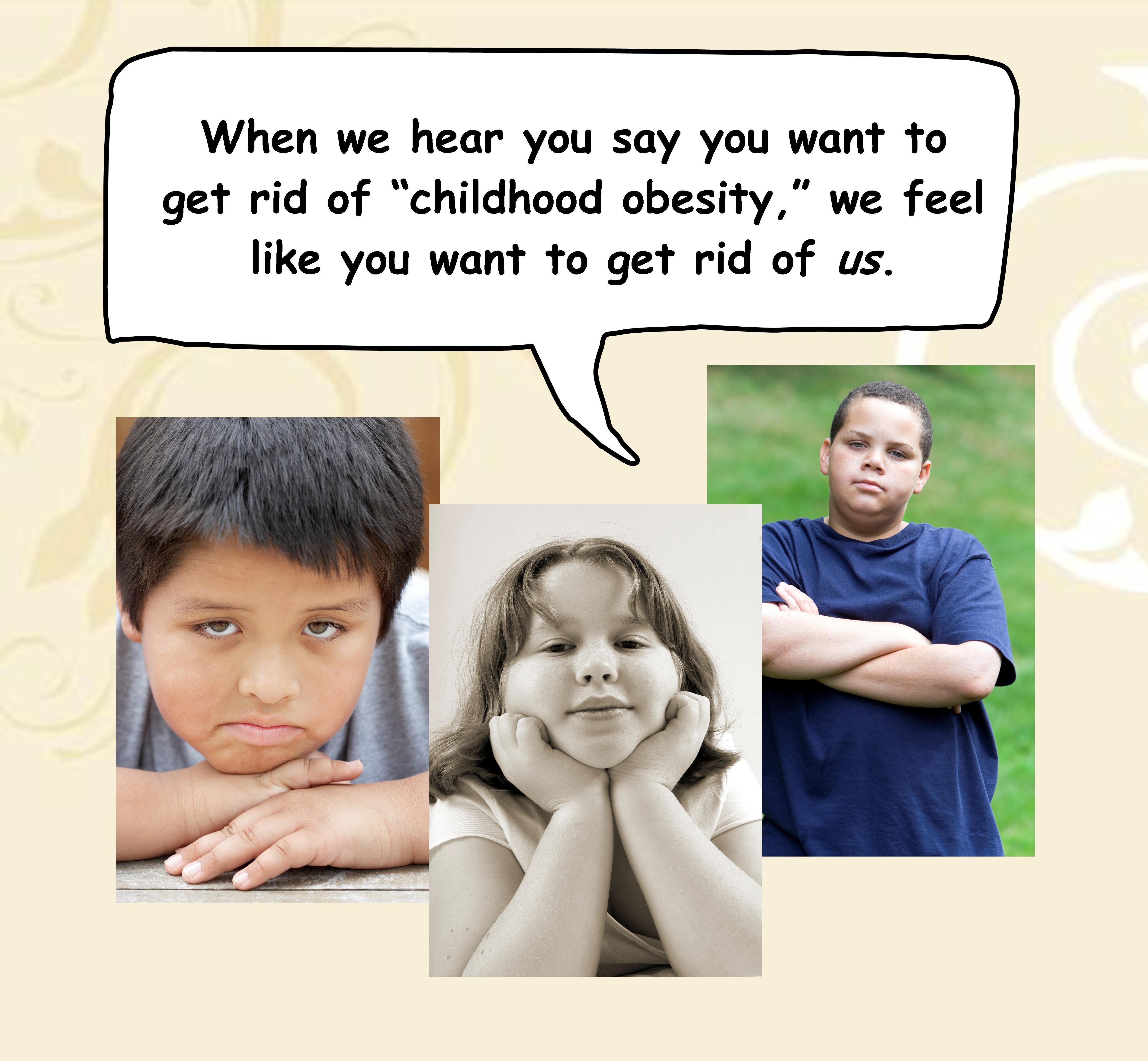By Dana Schuster
 We are all painfully aware that we live in a culture rife with judgment and bias, and a disturbing tendency to pit one group or viewpoint against another. While voices have recently been increasing in volume that say we must acknowledge and combat stigma and bullying, particularly among our youth, consider, if you will, the following scenarios.
We are all painfully aware that we live in a culture rife with judgment and bias, and a disturbing tendency to pit one group or viewpoint against another. While voices have recently been increasing in volume that say we must acknowledge and combat stigma and bullying, particularly among our youth, consider, if you will, the following scenarios.
- You walk onto your local high school campus and observe a gym class on the track. A group of lean-looking boys are sprinting in the front, and a fat girl walks at the back, away from the others.
- It's lunchtime at your local elementary school and as you walk by you see a fat boy sitting alone on a bench eating a piece of pizza.
- You are out shopping at the mall and pass two teens coming out of the ice cream shop eating sundaes, one of whom is thinly built, the other has a round body.
Be honest...what were your first thoughts? Perhaps words like "unmotivated" or "poor eating habits" or "no wonder s/he is fat" jumped into your mind. Did you automatically think the boys at the front of the pack on the track were healthy? Did you judge that slice of pizza as "bad" food? Was your reaction to the thin ice cream eater different than your thought about the larger consumer? If so, you are certainly not alone.
In a world dedicated to fighting a "war on obesity" people are often quick to make behavioral and/or health assumptions based solely on observed body size. All of the aforementioned thoughts, however, are evidence of discriminatory "sizeist" thinking, which directly contributes to the prevalence of size-based bullying and stigmatization.
By the way, that group of boys sprinting on the track just might contain a couple exercise bulimics. And that pizza - could be a school provided whole wheat and nutrient laden option that may well be the only hot meal the boy receives that day. Interestingly, ice cream is no more/less a healthy choice for the thinly built person than the round bodied one.
Size-based bullying is actually one of the most prevalent forms of abuse in our schools, with staff indicating weight-related bullying to be more frequently observed than bullying based on sexual orientation, disability, race, sexism, or religion. Additionally, recent research out of Yale indicates that the likelihood of being bullied is 63 percent higher for an "obese" child compared to a "healthy weight" peer. Just a couple of years ago, September was declared national "Childhood Obesity Awareness" month, with the focus on providing programs and resources to help reduce the number of fat children and youth in our communities. Think for a moment, what might the reaction be to a "LGBT Awareness" month that was focused on identifying strategies to change gay or transgendered children and teens into heterosexual young people?
 We mistakenly believe body size/shape to be under our individual control, yet a wide variety of studies suggest that up to 80 percent of our body weight may be determined by our genetics. Add to that the variance in individual living conditions, social status, food and health care access, and myriad other economic and environmental issues that impact our bodies, and our level of "control" seems quite elusive. Yet, the belief in, and promotion of, weight-loss focused interventions continue despite the decades of evidence that confirms "the proven ineffectiveness of weight loss attempts."
We mistakenly believe body size/shape to be under our individual control, yet a wide variety of studies suggest that up to 80 percent of our body weight may be determined by our genetics. Add to that the variance in individual living conditions, social status, food and health care access, and myriad other economic and environmental issues that impact our bodies, and our level of "control" seems quite elusive. Yet, the belief in, and promotion of, weight-loss focused interventions continue despite the decades of evidence that confirms "the proven ineffectiveness of weight loss attempts."
Size bullying and stigmatization remains largely unrecognized in anti-bullying programs because it doesn't even occur to most people to consider it a problem. The mantra most of us were raised with that you can "never be too rich or too thin" coupled with the moral belief of "gluttony" (which people see as equated with fatness) is a "sin," leaves little room for size diversity and acceptance. It is way past time to change this.
Body shape, size and weight need to be listed alongside race, culture, sexual orientation, gender identity, etc., as characteristics of diversity to be protected. Our young people deserve to be taught—through both adult example and educational instruction—to value their own and others’ unique bodies, whether they be fat/thin, tall/short or any other combination of size and shape. We all need to check in with our preconceived biases and assumptions, and work to banish them from our perspectives.
There are organizations and individuals committed to raising awareness about issues of size discrimination and the bullying behavior this gives rise to. As a health and fitness educator, and proponent of the Health At Every Size® approach, I am dedicated to helping others understand the bias and stigma that results from the weight focus of our culture, and would be pleased to help connect people with resources in this regard. The stories I have heard from young people who have been harassed by both peers and adults because their bodies are viewed as being the "wrong" size, are heartbreaking. By coming to an understanding of this issue, and fully embracing body size, weight, and shape as aspects of human diversity we should accept and respect, the anti-bullying community can play a significant role in expanding the safety of our youth.
Dana Schuster is a Health and Fitness Instructor with a Masters in Rehabilitation Counseling. She is involved in the School Wellness Policy work at her local high school and elementary/middle school districts, as well as at the county level. Currently she serves as Vice President of the Association for Size Diversity and Health (ASDAH) which is a professional educational organization dedicated to promoting the weight-inclusive Health At Every Size® approach to wellness.
Add new comment